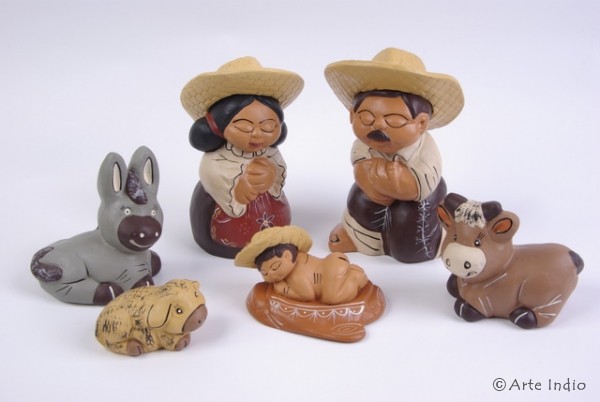
Prices incl. VAT plus shipping costs
Ready to ship today,
Delivery time appr. 1-3 workdays
- Order number: WK0004
Christmas cribs Arequipa
100% fair traded
Christmas Nativity figures
Set of 6 figures
Handmade
Dimensions:
Maria: 9 x 5.5 x 5.5 cm
Josef: 9.5 x 6 x 4.5 cm
Jesus: 7 x 5 x 4 cm
Donkey: 6.5 x 6.5 x 6 cm
Cow: 7 x 5 x 5 cm
Lamb: 4 x 3 x 2.5 cm
Material: clay
Origin: District of Lurin, 39.5 km south of Lima / Peru
Manufacturing cooperative: Jatari Wari
Illustration similar ...
About the craft:
The production of clay figures has a long tradition in Peru. These figures are made in different areas of Peru. Every region has its typical style. If you compare our different nativity figures, you will notice the difference. Just like the other ceramic articles made of clay, they are lovingly hand-painted after modeling.
In Catholic South America, Christmas cribs and crib figures are very popular during the Christmas season. With some figures you can clearly see the influence of the indigenous Indians. As in religion in the South American countries themselves, where Catholic elements are often mixed with traditional elements from the Inca period.
About the cooperative:
The cooperative was founded in Chorrillos in 2008. In 2009, the cooperative received a certificate of its work from the Ministry of Foreign Trade and Tourism.
Many of the members had already worked in ceramic production years before the cooperative in the arts and crafts was founded. Most of them started in Ayacucho. However, since there were increasing problems of terrorism in this region and the transport of goods was made difficult by poor transport connections, the artisans gradually immigrated to the Limas district. The founding of the cooperative was very difficult at the beginning. Many of the members had different interests and opinions and at the same time had little experience with such a project. However, they all pursued one goal together: They wanted to work together as a unit in order to benefit as a unit. The cooperative was founded on its own initiative, tools or other materials were very rare, the efforts of the artisans themselves helped to make the cooperative a success.

